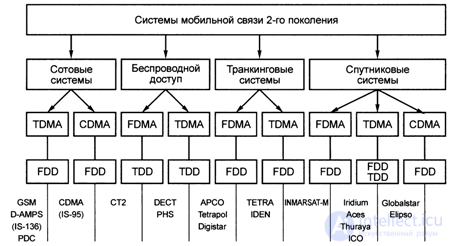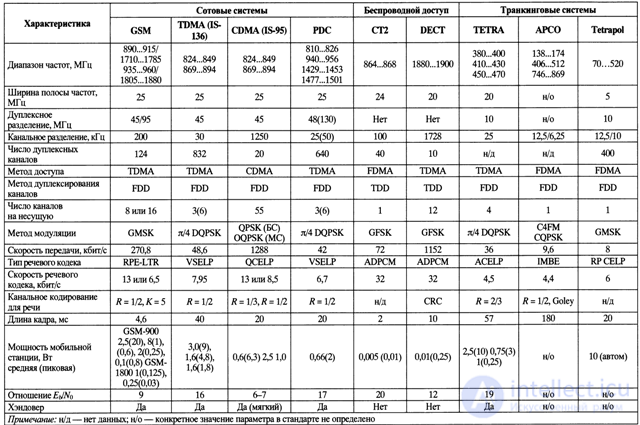Lecture
Digital mobile communication systems of the 2nd generation appeared at the beginning of the 90s, and they differed from analog systems by two fundamental features:
- the possibility of using spectral-efficient modulation methods in combination with time (TDMA) and code (CDMA) channel separation instead of frequency division (FDMA) used in analog systems;
- providing users with a wide range of services by integrating voice and data with the ability to encrypt data.
In fig. 10.1 shows the 2nd generation mobile communication systems, which can be divided into 4 main classes:
1) cellular mobile communication systems with a range within a cell from 0.5 to 35 km (TDMA - FDD - [GSM, D-AMPS (IS-136), PDC]);
2) radio trunking systems with a service area radius from 2 to 50 km depending on the height of the antennae raising (FDMA - FDD - [APCO, Tetrapol, Digistar], TDMA -FDD - [TETRA, IDEN]);
3) wireless access systems with typical cell sizes up to 0.3 km (FDMA - TDD - ST2, TDMA - TDD - [DECT, PHS]);
4) satellite communication systems with a service area in one beam 400 ... 800 km and a global service area for one satellite 3000 ... 8000 km depending on the height of the orbit (FDMA - FDD - INMARSAT-M, TDMA - FDD - [ICO , AceS, Thuraya], TDMA -TDD - IRIDIUM, CDMA - FDD - [GLOBALSTAR, ELIPSO]).
The differences between the systems of different classes of the 2nd generation are as follows:
- on communication: in cellular systems and wireless access systems, individual calls are made between subscribers, the average call duration can reach several minutes; in trunking systems, short messages are transmitted (no more than 1 minute), while communications can be organized individually and through the dispatcher (the connection establishment time does not exceed 0.3 s);
- by the way of using the frequency resource: mobile communication systems can be divided into two classes: 1) systems with channels fixed to subscribers,
2) systems with the provision of a channel on demand when subscribers are in the common service area; while the first class was widespread
in conventional radio communication systems and in a number of trunking systems, and the second in cellular communication systems;
- in terms of traffic volumes: in cellular systems and wireless access systems, it is possible to service with a traffic density of up to 10,000 Erl / km2, for trunking systems - the volume does not exceed 1 ... 2 Erlang / km2;
- by cell size: for cellular systems, cell sizes depend on the density of subscribers per unit of radio coverage area and on the nature of the distribution of subscribers in the service area; at the same time, pico-cells with a radius of up to 100 m are created in places with an increased density of subscribers; micro-cells with radii from 100 to 500 m are organized in the areas of the most intensive development and with a high population density; the range of macrocell zones that cover the city and suburban areas does not exceed 30 ... 35 km; when servicing subscribers in rural areas, in remote and hard-to-reach areas, ground-based macro cells and mega-cells (with a radius of up to 400 ... 800 km) of space mobile communication systems can be used;
- in terms of the composition and quality of the services provided: the highest quality is provided by cellular systems and wireless access systems that provide full-duplex communication both for mobile subscribers and for communication with PSTN and ISDN networks, similar services, but with fewer capabilities, are implemented in space systems , and in trunking, half-duplex communication and group calling of subscribers are mainly used.

Fig.10.1. 2nd generation mobile communication systems:
TDMA - Time Division Multiple Access;
FDMA - Frequency Division Multiple Access; FDD - frequency division duplex transmission (Frequency Division Duplex);
TDD - time division duplex (Time Division Duplex);
D-AMPS - a cellular standard based on TDMA (Digital Advanced Mobile Phone Service) technology
In tab. 10.1 shows the comparative characteristics of the main systems of the terrestrial mobile communication of the 2nd generation.

Table 10.1. Comparative characteristics of the basic systems of terrestrial mobile communications of the 2nd generation.
From tab. 10.1 should:
- the listed standards of the three main land mobile communication systems have certain differences in the main parameters and, above all, in access methods, channel duplexing methods, number of channels per carrier, transmission rates, types of speech codecs, signal-to-noise ratio, etc .;
- these differences have led to the fact that the standards used were in principle incompatible, which in turn caused the desire of the international community to create a single standard for mobile communications of a global nature;
- The GSM 900/1800/1900 standard was created for compatibility of the European standards GSM 900, DCS 1800 and the American D-AMPS / 1900, which to a certain extent made it possible to combine the three standards and make it the single standard of the 2nd generation digital terrestrial mobile systems.
An analysis of the market for mobile communication systems [10.7] shows that the distribution of subscribers in the world according to technologies and standards of mobile communication systems as of 1998/1999 is as follows (Table 10.2):
- GSM standard dominated (44%) (while GSM 900 was used worldwide, GSM 1800 in Europe and Africa, and GSM 1900 in the USA and Canada),
- the second place was occupied by analog standards (30%),
- in digital systems, the second place was occupied by the D-AMPS standard (mainly in the USA),
- the third place was taken by the PDC standard (used only in Japan),
- the fourth place was occupied by the CDMA standard (mainly in the USA).

Table 10.2. The market for 2nd generation systems.
Thus, the existence of a large number of disconnected 2nd generation mobile communication networks against the background of the general trend of countries in the world towards economic integration required the creation of a single standard capable of providing subscribers with freedom of movement and maintaining service in any network regardless of where it is deployed.
This was the reason for the development of the concept of a unified standard called "Perspective land mobile telecommunications system of common use" - previously known as FPLMTS (Future Public Land Mobile Telecommunications System).
Comments
To leave a comment
GSM Basics
Terms: GSM Basics